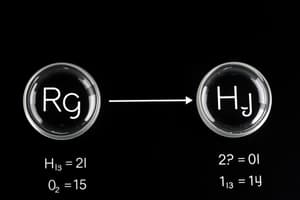Podcast
Questions and Answers
What is the molar mass of water (H2O)?
What is the molar mass of water (H2O)?
- 16 g/mol
- 14 g/mol
- 20 g/mol
- 18 g/mol (correct)
If 4 moles of a compound have a total mass of 88 grams, what is the molar mass of the compound?
If 4 moles of a compound have a total mass of 88 grams, what is the molar mass of the compound?
- 30 g/mol
- 24 g/mol
- 22 g/mol (correct)
- 20 g/mol
In a chemical reaction, if the maximum yield of a product is 50 grams but only 40 grams is produced, what is the percent yield?
In a chemical reaction, if the maximum yield of a product is 50 grams but only 40 grams is produced, what is the percent yield?
- 80% (correct)
- 90%
- 100%
- 70%
Given the reaction of nitrogen (N2) and hydrogen (H2) to form ammonia (NH3), if you start with 3 moles of N2 and 8 moles of H2, which is the limiting reactant?
Given the reaction of nitrogen (N2) and hydrogen (H2) to form ammonia (NH3), if you start with 3 moles of N2 and 8 moles of H2, which is the limiting reactant?
How do you calculate the maximum yield of a specified product given the masses of two reactants?
How do you calculate the maximum yield of a specified product given the masses of two reactants?
What is the molar mass of carbon dioxide (CO2)?
What is the molar mass of carbon dioxide (CO2)?
If a reaction produces 80 grams of product, and the maximum yield calculated was 100 grams, what is the percent yield?
If a reaction produces 80 grams of product, and the maximum yield calculated was 100 grams, what is the percent yield?
In a reaction where 10 grams of A are reacted with 20 grams of B, if B completely reacts and A remains, which of the following describes A?
In a reaction where 10 grams of A are reacted with 20 grams of B, if B completely reacts and A remains, which of the following describes A?
Given that the molar mass of sodium chloride (NaCl) is approximately 58.5 g/mol, how many grams are present in 2 moles of NaCl?
Given that the molar mass of sodium chloride (NaCl) is approximately 58.5 g/mol, how many grams are present in 2 moles of NaCl?
If 5 moles of a compound have a total mass of 150 grams, what is the molar mass of the compound?
If 5 moles of a compound have a total mass of 150 grams, what is the molar mass of the compound?
Flashcards are hidden until you start studying
Study Notes
Balancing Chemical Equations
- Adjust the coefficients in front of chemical formulas to ensure the number of atoms for each element is equal on both sides of the equation.
Molar Mass
- The mass of one mole of a substance, expressed in grams per mole (g/mol).
Mass from Moles
- Calculate the mass of a given number of moles using the formula: mass (g) = moles (mol) × molar mass (g/mol)
Molar Mass of Compounds
- Add the molar masses of all the atoms in the compound's chemical formula.
- For example, the molar mass of water (H₂O) is 18.015 g/mol (2 × 1.008 g/mol for hydrogen + 15.999 g/mol for oxygen).
Percent Yield
- A measure of the efficiency of a chemical reaction.
- Calculate it with the formula: percent yield = (actual yield / theoretical yield) × 100%
- Actual yield: the amount of product actually obtained in a reaction.
- Theoretical yield: the maximum amount of product that could be produced based on the stoichiometry of the reaction.
Identifying Limiting Reactants
- The reactant that is completely consumed in a chemical reaction.
- It determines the amount of product that can be formed.
- To identify the limiting reactant, calculate the moles of each reactant present and compare them to the stoichiometric ratio in the balanced chemical equation.
Maximum Yield
- Calculate the theoretical yield of a specified product by first determining the limiting reactant.
- Then use its moles and stoichiometric ratio to calculate the moles of product formed.
- Convert those moles to grams using the product's molar mass.
Percent Yield (with Actual Yield)
- Calculate the percent yield using the actual yield (the amount of product you actually got) and the theoretical yield (the maximum yield calculated earlier).
- Use the formula: percent yield = (actual yield / theoretical yield) × 100%
Balancing Chemical Equations
- Ensure that the number of atoms of each element on the reactant side of the equation equals the number of atoms of that element on the product side.
- Use coefficients in front of each chemical formula to balance the equation.
Molar Mass
- The molar mass of an element is the mass of one mole of that element.
- It is expressed in units of grams per mole (g/mol).
Mass of a Given Number of Moles
- To calculate the mass of a given number of moles, multiply the number of moles by the molar mass of the element.
- The formula is: mass = moles x molar mass.
- For example, to find the mass of 2.5 moles of carbon, you would multiply 2.5 moles by 12.01 g/mol (the molar mass of carbon), which gives you 30.025 g.
Calculating Molar Mass of a Compound
- To calculate the molar mass of a compound, add up the molar masses of all the atoms in the compound.
- For example, the molar mass of water (H2O) is 18.015 g/mol, calculated by adding the molar mass of two hydrogen atoms (2 x 1.008 g/mol) to the molar mass of one oxygen atom (15.999 g/mol).
Percent Yield
- Percent yield is the ratio of the actual yield of a reaction to the theoretical yield, expressed as a percentage.
- The formula is: percent yield = (actual yield / theoretical yield) x 100%.
- For example, if the theoretical yield of a reaction is 10 g and the actual yield is 8 g, then the percent yield is (8 g / 10 g) x 100% = 80%.
Maximum Yield
- The maximum yield of a reaction is the theoretical yield, which is the amount of product that would be obtained if the reaction went to completion with 100% efficiency
- It can be calculated using stoichiometry, the branch of chemistry that deals with the quantitative relationships between reactants and products in chemical reactions.
Limiting Reactant
- The limiting reactant is the reactant that is completely consumed in a chemical reaction, limiting the amount of product that can be formed.
- To identify the limiting reactant, you need to compare the moles of each reactant to the stoichiometric coefficients in the balanced chemical equation.
Actual Yield
- The actual yield is the amount of product that is actually obtained in a chemical reaction.
- It is often less than the theoretical yield due to factors such as incomplete reactions, side reactions, and losses during product isolation.
Studying That Suits You
Use AI to generate personalized quizzes and flashcards to suit your learning preferences.




